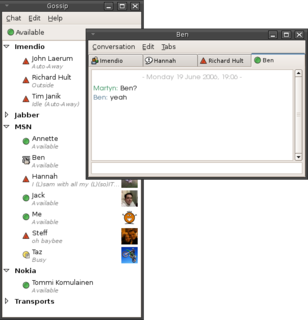
Red Hat, Inc. is an American software company that provides open source software products to enterprises. Founded in 1993, Red Hat has its corporate headquarters in Raleigh, North Carolina, with other offices worldwide.

Instant messaging (IM) technology is a type of online chat allowing real-time text transmission over the Internet or another computer network. Messages are typically transmitted between two or more parties, when each user inputs text and triggers a transmission to the recipient(s), who are all connected on a common network. It differs from email in that conversations over instant messaging happen in real-time. Most modern IM applications use push technology and also add other features such as emojis, file transfer, chatbots, voice over IP, or video chat capabilities.
Message-oriented middleware (MOM) is software or hardware infrastructure supporting sending and receiving messages between distributed systems. MOM allows application modules to be distributed over heterogeneous platforms and reduces the complexity of developing applications that span multiple operating systems and network protocols. The middleware creates a distributed communications layer that insulates the application developer from the details of the various operating systems and network interfaces. APIs that extend across diverse platforms and networks are typically provided by MOM.
Thomson Financial was an arm of the Thomson Corporation, an information provider. When the Thomson Corporation merged with Reuters to form Thomson Reuters in April 2008, Thomson Financial was merged with the business of Reuters to form the Markets Division of Thomson Reuters.

The Bloomberg Terminal is a computer software system provided by the financial data vendor Bloomberg L.P. that enables professionals in the financial service sector and other industries to access Bloomberg Professional Services through which users can monitor and analyze real-time financial market data and place trades on the electronic trading platform. It was developed by employees working for businessman Michael Bloomberg. The system also provides news, price quotes, and messaging across its proprietary secure network. It is well known among the financial community for its black interface, which has become a recognizable trait of the service. The first version of the terminal was released in December 1982.
WS-ReliableMessaging describes a protocol that allows SOAP messages to be reliably delivered between distributed applications in the presence of software component, system, or network failures.
Microsoft Message Queuing (MSMQ) is a message queue implementation developed by Microsoft and deployed in its Windows Server operating systems since Windows NT 4 and Windows 95. Windows Server 2016 and Windows 10 also includes this component. In addition to its mainstream server platform support, MSMQ has been incorporated into Microsoft Embedded platforms since 1999 and the release of Windows CE 3.0.
HCL Sametime Premium is a client–server application and middleware platform that provides real-time, unified communications and collaboration for enterprises. Those capabilities include presence information, enterprise instant messaging, web conferencing, community collaboration, and telephony capabilities and integration. Currently it is developed and sold by HCL Software, a division of Indian company HCL Technologies, until 2019 by the Lotus Software division of IBM.

Omron Corporation, styled as OMRON, is a Japanese electronics company based in Kyoto, Japan. Omron was established by Kazuma Tateishi (立石一真) in 1933 and incorporated in 1948.
In computing, the System Management BIOS (SMBIOS) specification defines data structures that can be used to read management information produced by the BIOS of a computer. This eliminates the need for the operating system to probe hardware directly to discover what devices are present in the computer. The SMBIOS specification is produced by the Distributed Management Task Force (DMTF), a non-profit standards development organization. The DMTF estimates that two billion client and server systems implement SMBIOS.

Component-based software engineering (CBSE), also called component-based development (CBD), is a branch of software engineering that emphasizes the separation of concerns with respect to the wide-ranging functionality available throughout a given software system. It is a reuse-based approach to defining, implementing and composing loosely coupled independent components into systems. This practice aims to bring about an equally wide-ranging degree of benefits in both the short-term and the long-term for the software itself and for organizations that sponsor such software.
Plumtree Software is a former software company founded in 1996 by product managers and engineers from Oracle and Informix with funding from Sequoia Capital. The company was a pioneer of extending the portal concept popularized by Yahoo! from the web to enterprise computing. BEA Systems acquired Plumtree on October 20, 2005, and Oracle subsequently acquired BEA. Plumtree's former portal product continues as part of Oracle's product line.
Mule is a lightweight enterprise service bus (ESB) and integration framework provided by MuleSoft. The platform is Java-based but can broker interactions between other platforms such as .NET using web services or sockets.
Power Plus Pro is a piece of financial software produced by Reuters Group in the form of an add-in for Microsoft Office Excel. A real-time data engine, it pushes new data into Excel when it receives notification of updates from a Reuters TIBCO bus or from Thomson Reuters' RMDS. This commonly involves live market data, such as stock prices, from a financial exchange. Using the addin, Excel can also contribute information to the TIBCO bus or to RMDS; such information then becomes available to other permissioned users using the addin on another computer or using Reuters 3000 Xtra stand-alone software. Power Plus Pro also has features which allow retrieval of historical market data.

Virtuoso Universal Server is a middleware and database engine hybrid that combines the functionality of a traditional relational database management system (RDBMS), object–relational database (ORDBMS), virtual database, RDF, XML, free-text, web application server and file server functionality in a single system. Rather than have dedicated servers for each of the aforementioned functionality realms, Virtuoso is a "universal server"; it enables a single multithreaded server process that implements multiple protocols. The free and open source edition of Virtuoso Universal Server is also known as OpenLink Virtuoso. The software has been developed by OpenLink Software with Kingsley Uyi Idehen and Orri Erling as the chief software architects.
Multipurpose Transaction Protocol (MTP) software is a proprietary transport protocol developed and marketed by Data Expedition, Inc. (DEI). DEI claims that MTP offers superior performance and reliability when compared to the Transmission Control Protocol (TCP) transport protocol.

TIBCO Software Inc. is an American business intelligence software company founded in 1997 in Palo Alto, California.
Reuters 3000 Xtra was an electronic trading platform which was released by Reuters in 1999 and supported until the end of 2013. It was typically used by professional traders and financial analysts in trading rooms. It was superseded by the Eikon platform, first released in 2010.

RML AgTech Pvt. Ltd., formerly known as Reuters Market Light was a business that provided Technology & Data Analytics Solutions to farmers and the agriculture value chain.

RocketMQ is a distributed messaging and streaming platform with low latency, high performance and reliability, trillion-level capacity and flexible scalability. It is the third generation distributed messaging middleware open sourced by Alibaba in 2012. On November 21, 2016, Alibaba donated RocketMQ to the Apache Software Foundation. Next year, on February 20, the Apache Software Foundation announced Apache RocketMQ as a Top-Level Project.









